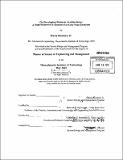| dc.contributor.advisor | Deborah J. Nightingale. | en_US |
| dc.contributor.author | Montoya, Mario, 1978- | en_US |
| dc.contributor.other | System Design and Management Program. | en_US |
| dc.date.accessioned | 2010-10-12T19:00:09Z | |
| dc.date.available | 2010-10-12T19:00:09Z | |
| dc.date.copyright | 2010 | en_US |
| dc.date.issued | 2010 | en_US |
| dc.identifier.uri | http://hdl.handle.net/1721.1/59261 | |
| dc.description | Thesis (S.M. in System Design and Management)--Massachusetts Institute of Technology, Engineering Systems Division, 2010. | en_US |
| dc.description | Cataloged from PDF version of thesis. | en_US |
| dc.description | Includes bibliographical references (p. 193-196). | en_US |
| dc.description.abstract | Early-stage enterprises are characterized by leveraging limited resources during periods of accelerating industry growth and relatively high uncertainty. This thesis is an examination of an early-stage enterprise within the medical technology industry using multiple frameworks. In addition to the standard Lean Advancement Initiative (LAI) suite of tools, the enterprise will be evaluated using Nightingale and Rhodes' eight Enterprise Architecture (EA) views, Kaplan's Balanced Scorecard (BSC), McKinsey's 7S framework, and Grave's Spiral Dynamics. Moreover, this thesis includes a practical examination of the current state using the framework developed by Piepenbrock's doctoral thesis that introduced the notion of modular versus integral enterprise architectures. A transformation plan is proposed based on the firm's current state and preferred future state based on insights from the various self-assessments and prevailing corporate strategy. The transformation plan is also informed by the author's perceived receptivity, commitment and need for change of the organization. The case organization's current state is described in general terms to protect the company's identity since the material presented includes portions of their corporate strategy and source of competitive advantage. Recognizing that all competitive advantage is temporary, considerable care has been exercised to balance the relevance of the research with the privacy needs of the organization. | en_US |
| dc.description.statementofresponsibility | by Mario Montoya, Jr.. | en_US |
| dc.format.extent | 196 p. | en_US |
| dc.language.iso | eng | en_US |
| dc.publisher | Massachusetts Institute of Technology | en_US |
| dc.rights | M.I.T. theses are protected by
copyright. They may be viewed from this source for any purpose, but
reproduction or distribution in any format is prohibited without written
permission. See provided URL for inquiries about permission. | en_US |
| dc.rights.uri | http://dspace.mit.edu/handle/1721.1/7582 | en_US |
| dc.subject | Engineering Systems Division. | en_US |
| dc.subject | System Design and Management Program. | en_US |
| dc.title | On developing business architectures : a multi-framework evaluation of an early-stage enterprise | en_US |
| dc.type | Thesis | en_US |
| dc.description.degree | S.M.in System Design and Management | en_US |
| dc.contributor.department | System Design and Management Program. | en_US |
| dc.contributor.department | Massachusetts Institute of Technology. Engineering Systems Division | |
| dc.identifier.oclc | 667706619 | en_US |
